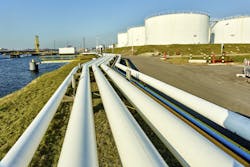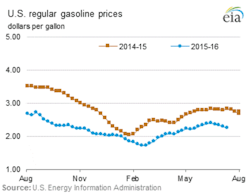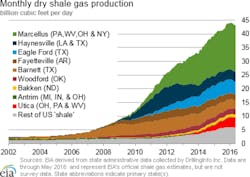Retail gasoline price down nearly 60 cents year over year
Graphic courtesy of the U.S. Energy Information Administration
The U.S. average regular gasoline price is down 58 cents from the same time last year, according to the U.S. Energy Information Association (EIA). The price decreased to $2.25 per gallon, down four cents from the previous week. Each region of the U.S. saw falling prices, but the decline was largest in the Midwest, where it fell five cents to $2.16 per gallon.
Russian natural gas pipeline prices hit record low
In May 2016, Russian natural gas pipeline prices at the German border dropped to $3.99 per million British thermal units (MMBtu), the lowest since September 2004. The U.K.’s National Balancing Point, a key European natural gas pricing benchmark, averaged spot prices at $4.86/MMBtu in June.
Despite the fall in prices, Russian and Norwegian exports to European Union countries have increased over the last year. Exports were 23 percent higher in the first quarter of 2016 as compared to the same period in 2015.
US natural gas prices rise for most
Largely attributed to western price increases and the limiting of Canadian imports, most regions’ prices outside of the Northeast rose recently.
Graphic courtesy of the U.S. Energy Information Administration
- The Henry Hub spot price rose 6 cents from $2.75/MMBtu to $2.81/MMBtu
- Chicago Citygate prices from 9 cents from $2.67/MMBtu to $2.76/MMBtu
- SoCal Citygate prices increased 33 cents from $2.47/MMBtu to $2.66/MMBtu.
- Algonquin Citygate prices fell 48 cents from $3.56/MMBtu to $3.08/MMBtu.
- Marcellus prices declined in the Tennesse Zone 4 (16 cents) and Dominion South (15 cents).
Natural gas supply flat while consumption increases
The supply of natural gas remained flat over last week at 797 Bcf/d. Dry production was also flat. While liquefied natural gas pipeline deliveries increased slightly, they contributed little to the overall supply.
U.S. natural gas consumption rose by 5 percent, with power burn accounting for more than half of the total consumption because of its 9 percent increase. Residential and commercial sectors consumption remained the same as the previous week with an average of 7.3 Bcf/d.




